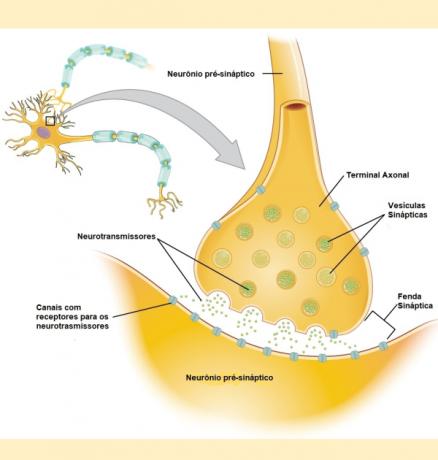Neurotransmitters are substances that make connections between two or more neurons, creating a chemical process in the synapse (a region located between neurons).
They are known as the body's chemical messengers as they are molecules used by the nervous system to transmit messages between neurons or from neurons to muscles.
Neurotransmitters are classified according to their influence on neurons and are arranged in three main categories:
- excitatory neurotransmitter: is one that generates an electrical signal, stimulating the target cell to act. These neurotransmitters are responsible for triggering actions in the body;
- Inhibitor neurotransmitter: is one that decreases the chances of the target cell to act and are responsible for inhibiting some type of action in the body;
- Modulating Neurotransmitters: Unlike the others, this type of neurotransmitter is not restricted to the synaptic cleft, therefore, they affect a large number of neurons at the same time, even if in a slower way.
The types of neurotransmitters and their functions
Many neurotransmitters are simply built from amino acids, while others are more complex molecules.
We currently know more than 100 neurotransmitters. We list and explain below some of the most known by people, for their important functions in our body such as: dopamine, acetylcholine, epinephrine, glutamate, gaba and serotonin.
dopamine
Dopamine is considered a special type of neurotransmitter because its effects are both excitatory and inhibitory. How it works depends on the type of receptor it binds to.
This neurotransmitter is important for movement coordination, inhibiting unnecessary movements such as regulation of the basal ganglia, which with too much dopamine, can result in uncoordinated activities and tics in the body human. In addition, dopamine is also responsible for growth hormone.
Serotonin
It is an inhibitory neurotransmitter and is directly linked to emotion and mood. Among its many functions are the regulation of body temperature, pain perception, emotions and the sleep cycle.
Insufficient doses of serotonin can result in a decrease in immune system function, in addition to various emotional disorders such as depression, anger management issues and disorder. obsessive-compulsive.
brag
It is one of the main inhibitory neurotransmitters. It is produced by neurons in the spinal cord, cerebellum, basal ganglia, and many areas of the cerebral cortex.
The functions of Gaba, like serotonin, are directly linked to mood and emotions. It is an inhibitory neurotransmitter that acts as a “brake” on excitatory neurotransmitters. Therefore, when it is abnormally low, it can lead to anxiety.
Its main function is to reduce neuronal excitability throughout the nervous system, minimizing brain activity, reducing stress and anxiety.
glutamate
Glutamate is an excitatory neurotransmitter present in the central nervous system. It acts to regulate the general excitability of the central nervous system, learning processes and memory.
Inadequate glutamate neurotransmission may contribute to the development of epilepsy and cognitive and affective disorders.
epinephrine
Also known as adrenaline, epinephrine is an excitatory neurotransmitter produced by cells in the adrenal gland.
Its main function is to prepare the body for a fight-or-flight reaction. This means that when a person is highly stimulated (fear, anger, etc.), extra amounts of adrenaline are released into the bloodstream.
This release of epinephrine increases heart rate, blood pressure, and liver glucose production.
Acetylcholine
Acetylcholine is an excitatory neurotransmitter and its main function is to stimulate muscle contraction. However, there is an exception where acetylcholine is an inhibitory neurotransmitter, which happens in the synapses between the vagus nerve (the largest cranial nerve connecting the brain with the spinal cord) and muscle fibers cardiac arrests. In this case, acetylcholine causes bradycardia, which is a decrease in heart rate.
How do neurotransmitters work?
For some vital actions to occur in our body, such as bone development, heartbeats cardiac and even anxiety control, it is necessary that neurons are able to communicate, transmitting signals. However, they are not connected, and consequently cannot carry out this direct communication. This happens because between them there is a space called synapse.
That's when the neurotransmission. It allows neural signals to cross the synapse, so that communication between two or more neurons occurs, through neurotransmitters.
As illustrated in the image below, the neurons approach each other but never touch. The neuron above the synaptic cleft is known as presynaptic neuron, the neuron that is located after the cleft is called postsynaptic neuron.
 It is possible to see the moment when synaptic vesicles release neurotransmitters that begin to bind to the membrane receptors of the postsynaptic neuron, initiating some action in the body.
It is possible to see the moment when synaptic vesicles release neurotransmitters that begin to bind to the membrane receptors of the postsynaptic neuron, initiating some action in the body.
With the neurons close to each other, neurotransmitters come into action, which have the function of carrying the message from the presynaptic neuron to the postsynaptic neuron. Thus, communication is made between them, inducing a specific type of action in the body.
It is worth remembering that neurotransmitters are produced in the presynaptic neuron and are stored in vesicles, also known as synaptic sacs. When communication is about to take place, the vesicles are positioned at the end of the presynaptic neuron, waiting for the stimulus to release the neurotransmitters.
This stimulus takes place through an action potential that arrives at the membrane of the presynaptic neuron. Thus, calcium channels, also located in the cell membrane of the presynaptic neuron, open and enter the neuron.
The entry of calcium creates the necessary stimulus for the vesicles to reach the end of the presynaptic neuron, fusing with its membrane and releasing neurotransmitters into the synaptic cleft.
It is from there that the neurotransmitters bind to specific receptors located on the membrane of the postsynaptic neuron. The action that takes place in the body after this connection depends on the type of neurotransmitter that was released
See also the meaning of monosodium glutamate and dopamine.
